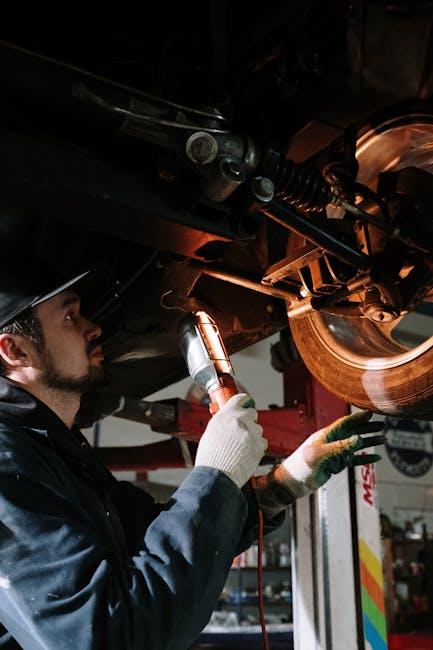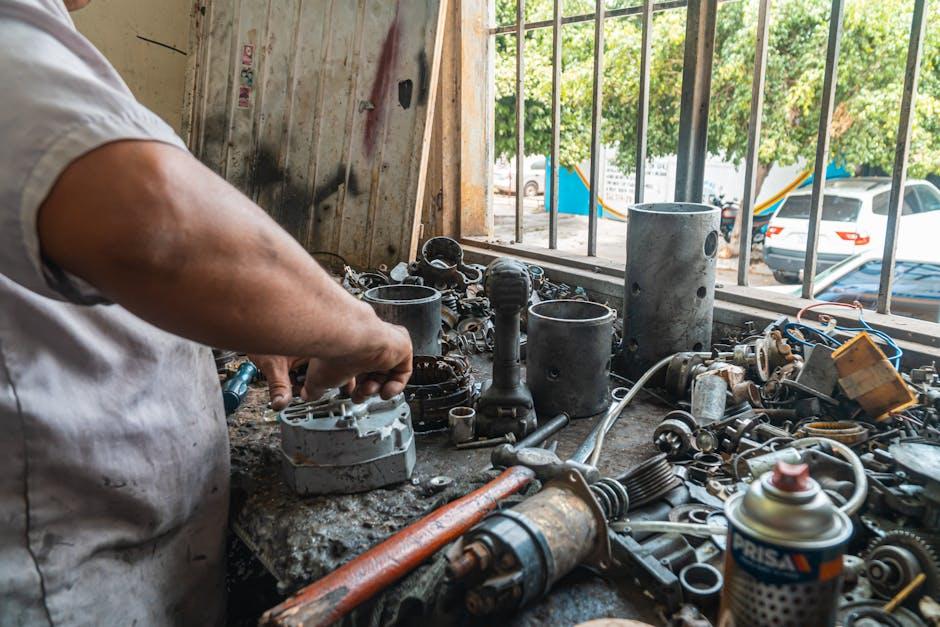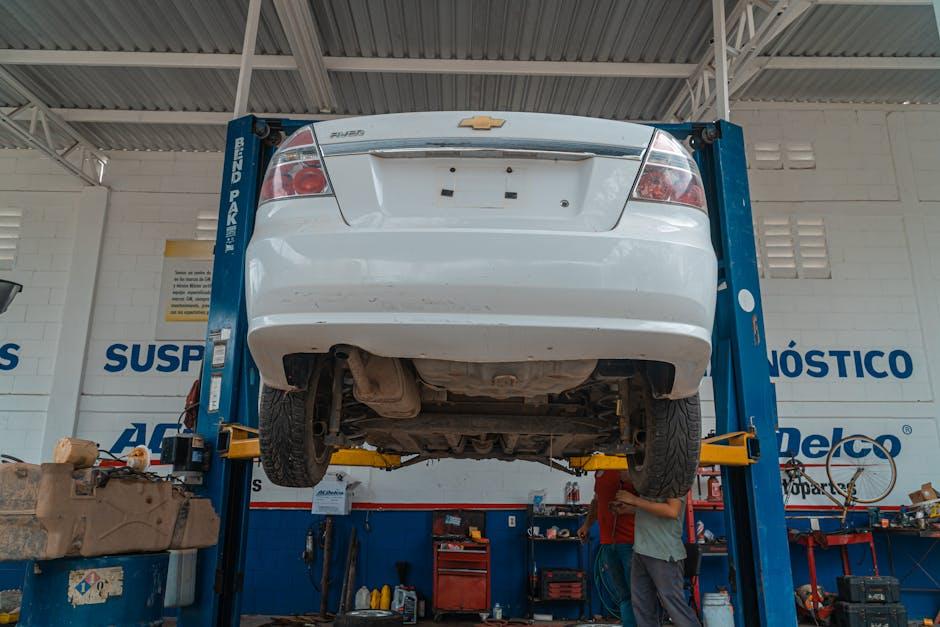A car’s suspension system is like its unsung hero, quietly smoothing out the bumps and jolts of the road to deliver a comfortable ride. But when that hero starts making noise, it’s a signal that something is amiss beneath the surface. Diagnosing a noisy suspension can be a puzzling challenge—after all, the sounds can vary widely, and their causes are often hidden out of plain sight. In this article, we’ll explore a methodical approach to pinpointing the source of suspension noise, helping you transform that mysterious clunk or creak into clear insight. Whether you’re a seasoned mechanic or a curious driver, understanding how to diagnose noisy suspension can save you time, money, and the stress of unexpected breakdowns.
Table of Contents
- Understanding the Root Causes of Suspension Noise
- Identifying Common Symptoms and Warning Signs
- Step-by-Step Visual and Physical Inspection Techniques
- Essential Tools for Accurate Suspension Diagnosis
- Interpreting Different Types of Suspension Noises
- Practical Tips for Preliminary Troubleshooting and Safety Checks
- Q&A
- In Summary

Understanding the Root Causes of Suspension Noise
Suspension noise often signals underlying issues that can impact driving comfort and vehicle safety. Common culprits include worn-out bushings, loose components, or damaged shock absorbers, each contributing distinct sounds such as clunks, rattles, or squeaks. In many cases, exposure to rough roads or lack of regular maintenance accelerates the deterioration of these parts, making early diagnosis essential. Understanding how each element functions within the suspension system helps pinpoint whether the noise stems from friction, looseness, or impact absorption problems.
To simplify troubleshooting, consider the following typical sources of suspension noise:
- Ball Joints: Wear here often generates a knocking sound during turns or uneven terrains.
- Control Arm Bushings: Cracked or dried bushings produce creaks, especially when navigating bumps.
- Shock Absorbers: Leaking or broken shocks may cause clunking or excessive bouncing.
- Sway Bar Links: Loose or fractured links result in rattling noises when cornering.
| Suspension Part | Common Noise | Diagnostic Tip |
|---|---|---|
| Ball Joint | Knocking | Listen when turning sharply |
| Control Arm Bushings | Creaking | Check after hitting bumps |
| Shock Absorbers | Clunking | Observe during braking |
| Sway Bar Links | Rattling | Feel vibrations in corners |

Identifying Common Symptoms and Warning Signs
When your vehicle’s suspension begins to announce its discomfort, the sounds it makes can serve as crucial clues. Listen closely for creaks, clunks, or squeaks during turns, bumps, or when driving over uneven surfaces. These noises often indicate worn-out bushings, failing shocks, or loose components. Additionally, be wary of a knocking sound when going over potholes—this can signal broken or weakened suspension parts that require immediate attention.
Besides auditory signals, pay attention to physical symptoms such as:
- Uneven tire wear, which may suggest misaligned suspension
- Vehicle pulling to one side, hinting at imbalance or damaged components
- Excessive bouncing after hitting a bump, indicating worn shock absorbers
- Steering instability at higher speeds
| Symptom | Possible Cause |
|---|---|
| Squeaking while turning | Dry or damaged bushings |
| Knocking over bumps | Broken/misaligned suspension arms |
| Uneven tire wear | Misaligned suspension |
| Excessive bounce | Worn shocks or struts |

Step-by-Step Visual and Physical Inspection Techniques
Begin by parking your vehicle on a flat surface and ensuring the wheels are securely chocked. A handheld flashlight will be invaluable for uncovering hidden wear or damage. Start with a visual sweep of the suspension components. Look closely for cracked bushings, leaking shock absorbers, and corroded springs. Don’t forget to examine the rubber boots around ball joints and tie rods, as tears here often herald noise issues. Use your hands to gently wiggle components like the sway bar links and control arms, feeling for looseness or excessive play that could cause clunking sounds during motion.
Next, perform a physical inspection by bouncing each corner of the vehicle firmly; your goal is to observe the response of the shock absorbers—if the car continues to oscillate more than once or twice, wear is likely present. When possible, have a helper slowly turn the steering wheel back and forth while you listen closely at each suspension joint for creaks or grinding. Use the following checklist to systematically assess potential noise culprits:
- Shock Absorbers: Check for oil leaks and resistance.
- Springs: Look for cracks, sagging, or breaks.
- Bushings: Identify cracks, tears, or hardened rubber.
- Ball Joints & Tie Rods: Test for excessive play and noise.
- Sway Bar Links: Check for looseness or damaged end links.
| Symptom | Likely Cause | Inspection Tip |
|---|---|---|
| Clunking over bumps | Worn bushings or ball joints | Listen while bouncing car corners |
| Squeaking noise while turning | Dry or damaged sway bar links | Turn steering wheel slowly while observing links |
| Continuous bouncing | Faulty shock absorbers | Press down each corner and observe rebound |

Essential Tools for Accurate Suspension Diagnosis
When tackling the mystery of a noisy suspension, having the right diagnostic equipment can make all the difference. Tools such as a stethoscope or a dedicated chassis ear amplifier allow you to pinpoint the exact source of unwanted noises by amplifying sounds from various suspension components as you manipulate the vehicle. Additionally, a hydraulic floor jack combined with sturdy jack stands is crucial for safely lifting and supporting the vehicle, giving you clear access to inspect shocks, struts, bushings, and ball joints without risking injury or vehicle damage.
Beyond basic lifting and listening tools, incorporating a few specialized devices enhances precision and speed during your assessment. An electronic suspension analyzer provides real-time data on damper performance and ride quality, while a torque wrench ensures suspension fasteners meet manufacturer specifications, preventing premature wear caused by incorrect tightening. Investing in these can streamline your diagnostic process and help isolate noisy suspension problems with surgical accuracy.

Interpreting Different Types of Suspension Noises
When your suspension starts to make noise, identifying the type of sound can provide crucial clues about the problem. A creaking or squeaking noise usually suggests that the bushings or ball joints are worn out and need lubrication or replacement. On the other hand, a clunking or banging sound typically points to loose or damaged shock absorbers or struts, especially if the noise increases when driving over bumps. Recognizing these subtle differences can save you time and money by focusing repairs on the right components from the start.
Different noises correlate with specific suspension issues, and a quick reference can help you troubleshoot effectively:
| Noise Type | Possible Cause | Common Location |
|---|---|---|
| Creaking/Squeaking | Dry/Worn Bushings | Control Arms, Ball Joints |
| Clunking/Banging | Loose/Damaged Shock Absorbers | Struts, Shock Mounts |
| Rattling | Broken Springs or Loose Components | Coil Springs, Stabilizer Bars |
| Knocking | Worn Tie Rods or Steering Linkages | Steering Assembly |

Practical Tips for Preliminary Troubleshooting and Safety Checks
Before diving into complex repairs, start with a few simple yet effective checks to isolate the root cause of your noisy suspension. First, visually inspect the suspension components for any obvious signs of wear or damage such as cracked bushings, leaking shock absorbers, or loose bolts. Pay special attention to the wheel wells and undercarriage, where road grime can sometimes mask problems. Remember to perform these checks on a level surface and engage the parking brake to ensure safety. If your vehicle is equipped with air suspension, make sure air lines and bags are intact and free from punctures or leaks.
While performing these preliminary observations, always prioritize safety. Use sturdy jack stands if you need to lift the vehicle, and never rely solely on a hydraulic jack. To help you keep track, here’s a quick reference table summarizing key components and common issues to look for during your walkthrough:
| Component | Common Issue | Checklist Action |
|---|---|---|
| Shock Absorber | Leaking fluid or worn seal | Check for oil stains around the cylinder |
| Coil Spring | Cracks or sagging | Inspect for uneven height or visible breaks |
| Control Arm Bushings | Cracked or hardened rubber | Look for cracks, excessive play, or missing pieces |
| Ball Joints | Excessive looseness or noise | Check for play with a pry bar carefully |
Q&A
Q&A: How to Diagnose Noisy Suspension
Q1: What are the common signs that my vehicle’s suspension is making noise?
A: Noisy suspension often reveals itself through creaks, clunks, rattles, or squeaks when driving over bumps, turning corners, or even during normal acceleration and braking. You might also notice vibrations or a rough ride, which can hint at suspension troubles.
Q2: What causes a suspension to make noise?
A: Suspension noise can stem from worn or damaged components like bushings, ball joints, shock absorbers, struts, or springs. Dirt, rust, or lack of lubrication can also contribute to those unwanted sounds.
Q3: How can I safely identify the source of suspension noise?
A: Begin by performing a visual inspection: look for cracked or degraded rubber bushings, leaking shock absorbers, or broken springs. Next, try a bounce test by pressing down on each corner of the vehicle and listening for excessive noise or poor rebound. Finally, test-drive the car slowly over different surfaces to narrow down when and where the noise occurs.
Q4: When should I seek a professional for suspension noise diagnosis?
A: If the noise persists despite your basic checks, or if you notice steering issues, uneven tire wear, or handling problems, it’s wise to consult a professional. Suspension systems are complex and critical to safety, so expert assessment ensures correct diagnosis and repair.
Q5: Can DIY repairs fix noisy suspension issues?
A: Some minor issues, like lubricating bushings or tightening loose components, can be done at home if you’re comfortable with basic tools. However, replacing shocks, struts, or joints usually requires specialized equipment and knowledge. When in doubt, trust the pros.
Q6: Does suspension noise affect vehicle safety?
A: Absolutely. Noisy suspension may indicate compromised parts that reduce ride comfort, control, and braking efficiency. Addressing the problem promptly helps maintain safe handling and prevents costly damage down the road.
Q7: How can I prevent suspension noise from developing?
A: Regular maintenance is key. Keep your suspension clean, inspect components periodically, replace worn parts timely, and avoid aggressive driving on rough terrain. These habits prolong suspension life and keep your ride quiet and smooth.
In Summary
In the pursuit of a smooth and quiet ride, understanding the subtle signs of a noisy suspension can save you time, money, and unexpected roadside frustration. By honing your senses and following these diagnostic steps, you transform from a passive passenger into a proactive caretaker of your vehicle’s comfort and safety. Remember, every creak and rattle tells a story—listen closely, act wisely, and keep your journey rolling with confidence.


2 Comments
bc3rxc
bc3rxc